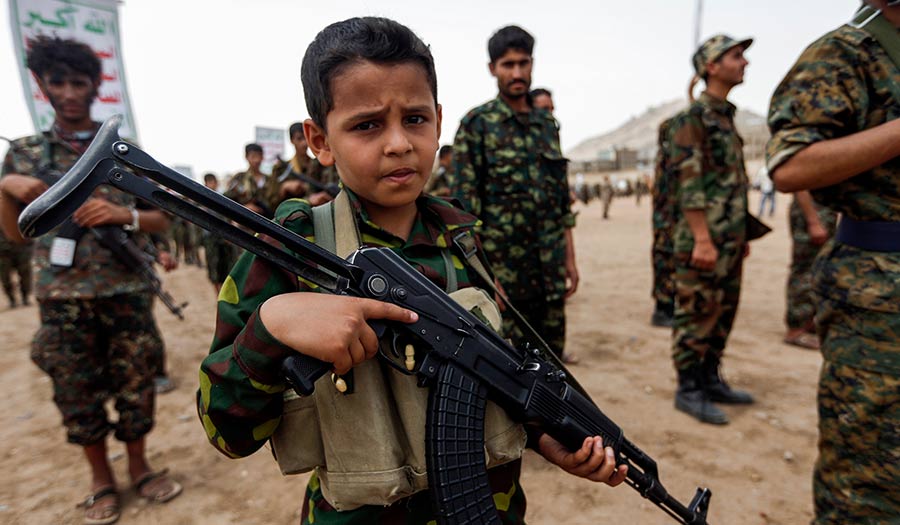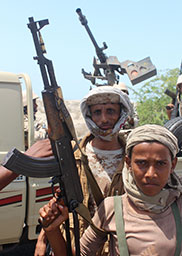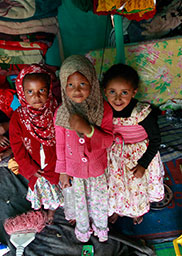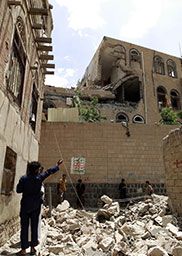 Mohammed Huwais/AFP via Getty Images
Mohammed Huwais/AFP via Getty Images
A Yemeni boy poses with a Kalashnikov assault rifle during a gathering of newly-recruited Huthi fighters (July 16, 2017).
Citizens of the fractured Middle East nation continue to suffer and historical examples paint a bleak picture of its future. Yet there is hope for the Yemeni people.
Subscribe to the Real Truth for FREE news and analysis.
Subscribe NowAt 5 months old, a Yemeni girl in a hospital bed has already suffered more than many do in a lifetime. Oxygen and IV tubes dangle from her body, and she clings to life similar to the way her wrinkly, malnourished skin does to her bones. Despite medical intervention, her heart stops beating days later as she succumbs to starvation.
Later, hospital staff prepare the bed for another who will likely suffer the same fate.
This is the all-too-common end for the 300,000 starving Yemeni children who live without regular access to food, medical attention, and safety. As the nation’s year-plus civil war continues, this number ticks upward.
The conflict between Yemen’s government and rebel groups—which is complicated by various terrorist organizations and tribal factions—has the average citizen trapped and helpless. Even young Yemenis not threatened with starvation live in a failed system where they grow up with little or no education, money or hope. They face a future of scavenging food and a just-scraping-by existence.
 Saleh Al-Obeidi/AFP/Getty Images
Saleh Al-Obeidi/AFP/Getty ImagesMired in conflict: Forces loyal to Yemen’s president, Abed Rabbo Mansour Hadi, show their weapons as they take part in an operation against al-Qaida (April 23, 2016).
The resultant humanitarian crisis from war is crushing Yemen, the poorest sovereign state in the Middle East. Unemployment stands above 40 percent. Fourteen million people require food assistance or are at risk of starvation, Jamie McGoldrick, the United Nations Humanitarian Coordinator in the nation, reported. In addition, seven million live in areas prone to airstrikes and violent attacks.
According to the International Organization for Migration and the UN Refugee Agency, about 2.5 million have left their homes. Yet most are stuck within Yemen’s borders, an area roughly four times the size of the U.S. state of Alabama.
Three million Yemeni youth are unable to attend school. Summing up their plight, Mr. McGoldrick told Euronews: “So for [the children] it is a life with pain, no life at all but pain. And if you look at the situation regarding health structures, the inability for people to bring food into this country, to bring medicine into this country, to bring fuel into this country, is hampering the possibility for them having a future.”
For most in the nation, there is only one place to go to attempt to escape the horrors surrounding them: basements. Unlike northern Africa and Syria, from which migrants are fleeing by the thousands into Europe, Yemen and its surrounding region is a geographical maze. Relocating outside its borders—and even within the country—is often an impossible dream.
A Yemeni’s path to Europe would involve passing through life-threatening, mountainous territory either controlled by Houthi militants, terror groups, or aggressive tribal factions. Those who do cross the border into Saudi Arabia must travel thousands of miles through mountains and deserts amid further threats of violence before they can reach Turkey. At any point during the journey, there is a possibility of running into a band of ill-meaning bandits.
For those who can afford a boat ride out of the country—which include Yemen’s small higher class of lawyers, judges, medical workers, computer engineers, and university lecturers—escape to Africa via the sea is easier but equally risky. Attacks by Houthi gunmen or Somali pirates are common.
In one case, according to NPR, a Yemeni hospital worker “paid $300 to board a repurposed cargo ship at the port in the southern coastal city of Aden. Houthi rebels fired on them as they waited to board.”
In another instance, “…rockets allegedly fired by the same rebels sank a fleeing ship and killed at least 40 people.”
Of the 2.5 million Yemenis that have left their homes, only about 60,000 have escaped the country’s borders. Most of these traveled by land to neighboring Saudi Arabia and Oman, or by sea to Djibouti.
Others flee to humanitarian camps, which provide little security. One such IDP (internally displaced person) camp had four bombs dropped on it by Saudi warplanes. A survivor of the blasts told the online news organization Middle East Eye: “We thought we would be safe here, but the airstrikes follow us wherever we go.”
“At least at home we had food, we had our farmland, we had our goats. Here, we are starving. There is absolutely no one helping us.”
 Mohammed Huwais/AFP/Getty Images
Mohammed Huwais/AFP/Getty ImagesSeeking shelter: Yemeni children pose inside a tent at a makeshift camp after fleeing from fighting in Sanaa (April 16, 2016).
Those who do stay behind—the majority of citizens—are under the constant threat of shelling, gunfire or an airstrike. The United Nations reported that of the over 6,200 people killed in the civil war, about half have been civilians slain indiscriminately by gunfire or airstrikes.
Without a place to go, many Yemenis are left with just one option: hope that tomorrow will not bring more of the same.
Naturally, human beings are sympathetic. Many devote their lives to devising and implementing solutions of every form. Humanitarian aid groups bring food and equipment for shelter and healthcare to provide for the Yemenis who need help.
Even nations that get involved have a noble desire to create stability in the region. Each solution in this case, however, breeds contention and additional problems for others. Yet the future of the Yemeni state and its 24 million citizens hangs in doubt. So what can be done to save the population from reentering the dark ages?
Before looking at potential solutions to Yemen’s crisis, it is helpful to better understand the situation first.
The current civil war in Yemen is another example of tensions between long-time enemy Sunni and Shiite Islamic factions. It is primarily being fought between two political-religious groups: (1) Sunni Muslim forces loyal to President Abed Rabbo Mansour Hadi’s government (based in the coastal, southern city of Aden), and (2) the Shiite Muslim Houthis (based in the north), who have taken control of Sanaa, Yemen’s capital.
BBC explained: “The Houthis are members of a rebel group, also known as Ansar Allah (Partisans of God), who adhere to a branch of [Shiite] Islam known as Zaidism. Zaidis make up one-third of the population and ruled North Yemen under a system known as the imamate for almost 1,000 years until 1962.
“The Houthis take their name from Hussein Badr al-Din al-Houthi. He led the group’s first uprising in 2004 in an effort to win greater autonomy for their heartland of Saada province, and also to protect Zaidi religious and cultural traditions from perceived encroachment by Sunni Islamists.”
In 2012, when Mr. Hadi was elected president of a unified Yemen, the Houthis objected to his rule, citing state corruption. They captured Sanaa and ousted Mr. Hadi in January 2015.
 Mohammed Huwais/AFP/Getty Images
Mohammed Huwais/AFP/Getty ImagesAirstrike aftermath: Yemenis stand amid the rubble of houses following air strikes in Sanaa by the Saudi-led coalition (Sept. 16, 2015).
Complicating the picture is the fact that al-Qaida in the Arabian Peninsula (AQAP) claims over a quarter of Yemen’s territory. The militant Islamist group is not aligned with either Mr. Hadi or the Houthis. Instead, it has taken advantage of the power vacuum by expanding its influence and staging deadly attacks against Yemen’s government forces, the Houthis, and citizens.
Also, smaller tribal entities are trying to gain a footing amid the chaos. In late 2014, Sunni radical group San’a Province claimed responsibility for a suicide bombing in Sanaa that killed 152 people. The group affiliated itself with the Islamic State terror group (commonly called ISIS), which is seeking to eclipse AQAP’s influence.
Because of political instability and loss of infrastructure, some Yemenis are turning toward jihadist groups such as AQAP and ISIS to provide basic necessities.
International Business Times explained: “Half of Yemen’s 24.4 million people don’t have access to clean water—the most basic of human needs…But there’s a group working to change that. A group that…much to the delight of its parched residents—unveiled a freshly dug well in the country’s arid southern territory.” That group is AQAP.
“AQAP is one of the U.S.-designated terror organization’s most powerful divisions and since the beginning of 2016, the group has quietly seized vast swaths of Yemen, undercutting its rival, the Islamic State group, which has been the main focus of the West’s counterterrorism strategy for the last year. ISIS may have dominated international media coverage, but in Yemen, AQAP has overshadowed its younger sibling with its grassroots approach, providing essential public services to gain the trust of the local population. The group has also been willing to share power with local governing institutions before it establishes its own so-called caliphate.”
With the state splintering into pieces, key regional and international players have entered the arena to prevent its total collapse—even further complicating matters.
Stability in Yemen is important for peace in the entire Middle East. BBC explained: “Yemen is strategically important because it sits on the Bab al-Mandab strait, a narrow waterway linking the Red Sea with the Gulf of Aden, through which much of the world’s oil shipments pass. Egypt and Saudi Arabia fear a Houthi takeover would threaten free passage through the strait.”
Also, Yemen and Saudi Arabia share an over 900-mile border. The Saudis want to ensure their lands are secure from the Houthis.
Saudi Arabia claims that its archrival Iran, a Shiite nation, is supporting the Houthis with financial aid, weapons and training. Iran’s strategy is allegedly to use the group as a proxy of influence.
To counter the Houthis advance and concerns over Iran’s involvement, a coalition of Arab and African nations led by Saudi Arabia is backing Yemen’s government.
The coalition deploys jets to seek-and-destroy military targets in Houthis-controlled areas. There are, however, growing reports that it also indiscriminately bombs civilians—sometimes in retribution for military infringement. In September 2015, after 45 United Arab Emirate soldiers were killed by Houthi forces near the capital of Sanaa, UAE jets retaliated by dropping bombs on the city overnight. Thirty civilians were killed.
The coalition is also blocking imports by sea. While affecting the Houthis marginally, the blockade has greatly worsened starvation in a nation that relies on imports for 90 percent of its food.
Increasing instability and the threat of terror attacks emanating from the area have drawn the United States into the fray. Washington provides Mr. Hadi’s government and the Saudi coalition military support. But America’s primary objective in Yemen is to stop AQAP from expanding its influence, wealth and ability to carry out long-ranging terror attacks.
Washington has also expressed concern that Mr. Hadi’s security forces and the Saudi coalition do little to stop al-Qaida in the region. Realizing that the Houthis are more engaged in fighting AQAP, White House officials have been “scrambling to contact Houthi leaders and assure them that the United States doesn’t consider them an enemy,” Los Angeles Times reported.
“Why so much eagerness for a working relationship with a group that wants less U.S. influence in its homeland, not more?” the media outlet continued. “Because the Houthis and their allies are now in charge in Yemen, one of the main battlegrounds in the long U.S. war against Al Qaeda. And the Houthis hate Al Qaeda.”
Yet the Pentagon has been unable to establish contact with the Houthis. Their slogan, “Allah is great, death to America, death to Israel, curse on the Jews, victory to Islam,” reveals why.
Instead, the U.S. is urging the Saudi coalition to limit its use of force in the hopes of saving more lives and stabilizing the region. It is also puts consistent pressure on Yemen’s government to engage in peace talks with the Houthis.
Both sides have been reluctant to come to terms. Even if a ceasefire agreement was brokered, it could open the door for more complexity. For one, it would allow large numbers of citizens to flee within a short period of time, as people tend to move when fighting stops. Though this sounds positive for Yemenis, it would likely throw gasoline on the refugee crisis fire already vexing Europe and the Middle East. Refugees would then have little hope of finding a better life even if they were able to exit the country.
Worse—a ceasefire could fuel greater conflict. The New York Times reported: “…Yemenis scarred by the vicious fighting, past broken promises and deepening divisions say they fear that any truce would just be a prelude to an even uglier war, fought between regions, religious sects—even neighbors.”
“‘People have feelings of revenge,’ said Mohamed Nagy, whose house is on a hill less than a mile from one of the front lines in Taiz, a city that residents boasted was a beacon of culture and intellectual life in Yemen before it was transformed into one of the country’s deadliest battlefields.”
“The reconstruction of souls, by both sides, will take a long time,” Mr. Nagy told the paper.
Yemen has been trapped in a cycle of factional violence and division for more than 1,000 years. From AD 1047 to 1517, control of the area shifted between local dynasties, kingdoms and tribes. The city of Sanaa was conquered by invading forces nearly once every 100 years throughout this period.
As long as a common enemy was present, Yemeni peoples united. During the 16th and 17th centuries, the Ottoman Empire vied for control of Sanaa. Sunni and Shiite Yemenis joined forces and engaged in back-and-forth battles against the Turks for territory.
After these invaders were expelled, however, conflicts between Zaidi Shia tribes in the north and Sunni feudal systems in the south continued. By the mid-1800s, with Sanaa fractured by tribal rivalries, the city’s citizens were so desperate for a return of order that they appealed to the Turks to rule them. The Ottomans invaded in 1849, but failed to take the city. Despite this, the Ottoman Empire continued to hold some territory in Yemen until 1918.
During World War I, Yemen came under the influence of the British Empire and was effectively divided at the war’s end. North Yemen, called the Zaidi Mutawakkilite Kingdom of Yemen (1918-1962) and later renamed the Yemen Arab Republic (1962-1990), was an independent state with the Zaidis generally in power. It existed until 1990 when it unified with South Yemen, which was a British protectorate.
Shortly after unification in 1990, southerners “began complaining of political and economic marginalization by the government in Sanaa, and fought a civil war in 1994 in a failed attempt to reverse the unification,” BBC reported. Tension continued to mount between north and south over unequal access to power and resources.
The Houthis and Hadi-led government are the modern figures of this millennia-old divide, which is now further complicated by the involvement of AQAP and ISIS, as well as regional and global powers.
World history is a cycle: actions breed problems, which breed problem-solvers, who breed solutions, which breed unintended effects. As long as problems exist, man searches for solutions. Yet each of these solutions invariably prove the “law of unintended consequences.”
Recognizing this overall pattern shows a dire reality: man is incapable of creating lasting solutions. All of his plans backfire or have negative side effects. With this in mind, it may seem that Yemen is truly trapped in a never-ending war.
Yet grasping this truth leads to the best possible news for the faltering state and its suffering people.
Since man is incapable of governing himself, he needs outside help. The Bible reveals that someone can—and will— solve all of his problems.
Chapter 2 of the book of Daniel explains that “the God of heaven” will “set up a kingdom, which shall never be destroyed: and the kingdom shall not be left to other people, but it shall break in pieces and consume all these kingdoms, and it shall stand for ever” (vs. 44).
Do not dismiss this verse as either outdated Hebrew literature or too fantastical to ever come true. The Bible is filled with prophecy, which can be likened to history written in advance. When God says He will do something, He brings it to pass. Prophecy is one of the key ways to prove the validity of this Book. If you have not done so already, read Bible Authority...Can It Be Proven? It removes all doubt that God’s Word provides an outline for what will come upon the world.
Back to Daniel 2:44. This verse reveals two unique details regarding the kingdom that God will set up: (1) it will last forever, and (2) it will not be ruled by men.
For the majority of those in charge—governors, presidents, tribal leaders, and terrorist masterminds—this comes as horrible news. They will be out of jobs and power.
But for the average person, such as Yemenis trapped in a cycle of war, God’s kingdom will be a welcome relief.
Consider what the Bible says conditions will be like in cities. The following passage from the book of Zechariah is a future scene for Jerusalem, but these conditions will also be enjoyed worldwide: “Thus says the Lord of hosts; There shall yet old men and old women dwell in the streets of Jerusalem, and every man with his staff in his hand for very age” (8:4).
This is welcome news for places like Yemen—where an airstrike can come at any moment.
Verse 5 states what will come for children: “And the streets of the city shall be full of boys and girls playing in the streets thereof.”
For thousands of years, even man’s most successful empires, nations and kingdoms have risen and waned. None have ever brought lasting hope for the future.
Even with today’s most powerful nations and numerous humanitarian groups helping, Yemen remains in a lingering, debilitating war.
The government that God says He will establish will bring true lasting peace and prosperity for which Yemenis long. The generation stuck in the thicket of violence and poverty today will be rescued.
To learn how and when this will occur, read the comprehensive book Tomorrow’s Wonderful World – An Inside View! It proves beyond a doubt that the future of Yemen—and the world—is bright.